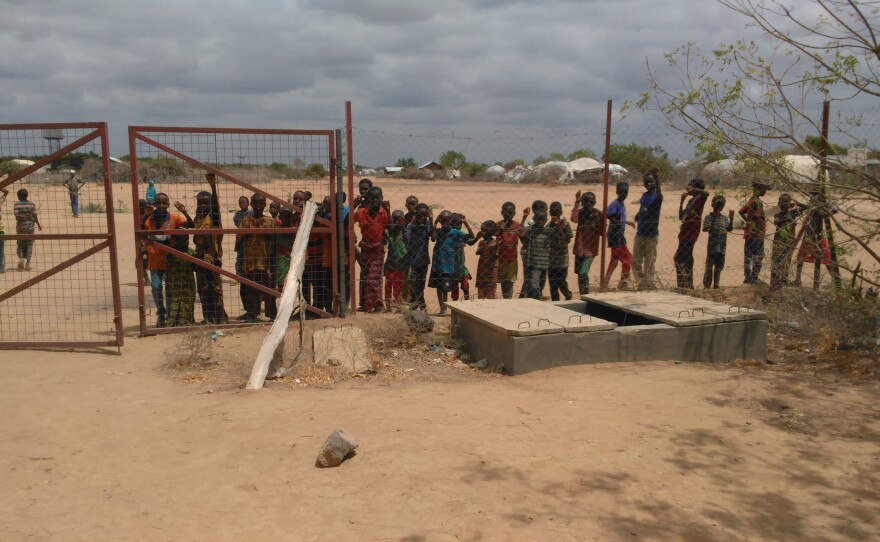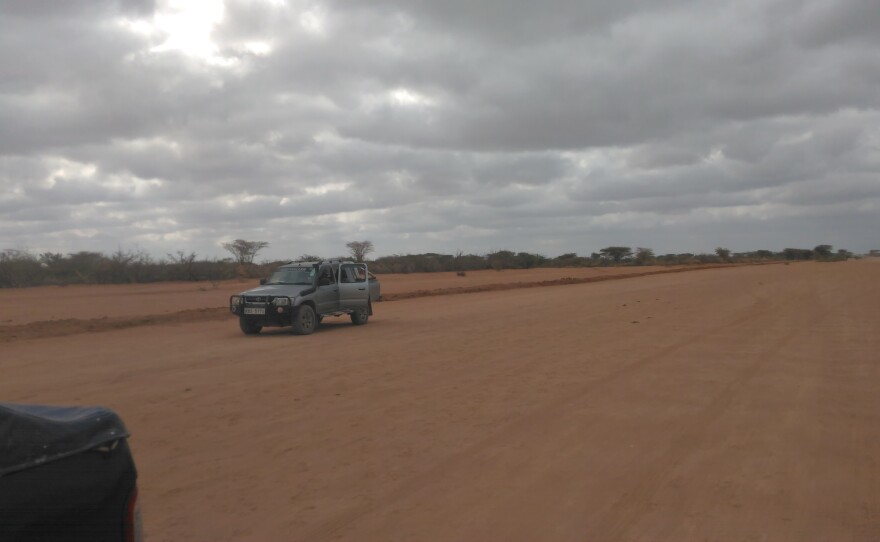DADAAB, KENYA — Here, at the largest refugee camp in the world, the name Trump is uttered hundreds of times a day.
[asset-audio[{"description": "Part 2 of Kate Walters' report from Dadaab, Kenya", "fid": "134459", "uri": "public://201703/NEWS_20170308_DaDab2_0.mp3"}]]
More than 265,000 people live at this sweltering desert crossroads, where hope is the only thing in abundance. That's why President Trump's immigration policies have landed like a gut punch, deflating dreams.
Most Dadaab residents are Somali, and many have lived here for more than two decades. It's not hard to find someone here with relatives or friends in Seattle, which has the third largest Somali population in the U.S.
Mohamed Abdi, for example, has lived in the camp for nearly 26 years. A close childhood friend moved to Seattle.
I sat down with him in a small tea shop in the camp, and he told me Dadaab is an unforgiving place where there’s never enough.
“If it’s food, if it’s medicine, if it’s any other service, it’s not enough for a family to survive. Because the life here is very harsh, very harsh,” he said.
Bare, red dirt stretches for miles, coating everything in a fine layer of dust. The heat is relentless, even in the shade. By 9 a.m. each day I’m drenched in sweat.
People seek relief in the structures they’ve built out of mud, sticks and sacks emblazoned with United Nations logos, faded by the sun.
[asset-images[{"caption": "Aerial view of part of the Dadaab refugee camp, Dadaab. By population, it's the third largest city in Kenya", "fid": "134391", "style": "placed_wide", "uri": "public://201703/IMG_20170216_112512.jpg", "attribution": "Credit KUOW Photo/Kate Walters"}]]This place is like a big, rural village. There are hospitals, schools, neighborhoods and markets. But there’s an undercurrent of desperation here. As Abdi says: “Nothing here is ever enough.”
Nobody wants to be here. It was supposed to be a stop on the way from fleeing conflict to gaining a better life elsewhere.
Abdi has watched people leave the camp for two decades — including his childhood friend.
All the while he wonders when his turn will come, when he can take his wife and two young children to resettle in the U.S.
He hopes to work as a nurse in America, as he does in the camp. But it’s not easy. The vetting process for resettlement is intense.
“Every step you pass, they’ll be vetting, extremely vetting. Like me, I went to my first interview in 2010. The second interview was 2016,” Abdi said.
The Trump administration has said this vetting process is not good enough, particularly for countries like Somalia with terrorist links. Trump wants to see a more rigorous system in place. He says tougher policies are needed to keep America’s borders safe, including his travel bans.
For Abdi, that stance has been a huge blow to his hope and morale. He can’t go back to Somalia, he said, because there’s too much uncertainty and conflict there. But he’s tired of waiting; it’s been more than six years since he started the resettlement process.
“And then if the president say that we’ll ban these from entering to the United States, it will harm us," he said. "The only hope that we have is to go to resettlement to live a better life and also to get a better education than this one.”
Like everyone else in the camp, Abdi has watched the Trump administration's moves on immigration policy closely.
After the first ban, many resettlement cases like Abdi’s were put on hold.
[asset-images[{"caption": "Salam Abdi Hadul and Mohamed Abdi ", "fid": "134415", "style": "placed_wide", "uri": "public://201703/l_to_r_-_salam_abdi_hadul_and_mohamed_abdi.jpg", "attribution": "Credit Rwaida Gharib"}]]Geno Teofilo is with the Norwegian Refugee Council, one of the humanitarian groups working in Dadaab. He said the Trump administration’s approach to immigration has been disillusioning for refugees.
“These refugees are people," Teofilo said. "They deserve better. They are not ping pong balls who should be knocked back and forth between being allowed to resettle in the USA and not.”
The impact goes beyond just individuals; it reverberates through the families living in the camp.
There are two groups of people in Dadaab: Those who have relatives who have made it to a country like the U.S., and those who don’t.
Those who have family abroad receive money and help from the outside. Those less fortunate must rely on what the U.N. provides. And as the U.N. deals with a tighter budget, even that help is stretched thin. Food rations have been cut back and families that don’t have help from overseas often run out of food several days before the next distribution takes place.
This harsh reality means people desperately want to get out of the camp. And since it feels like the U.S. door is closing on those who live in Dadaab, that’s contributed to more people returning to Somalia.
Each person leaving Dadaab receives $200 from the United Nations to help them start over at home. On any given day, hundreds of people line up to board colorful buses that will take them back across the border.
They’re giving up refugee status to take their chances with political instability and drought.
[asset-images[{"caption": "A family leaving Dadaab to try their luck in Somalia", "fid": "134416", "style": "card_280", "uri": "public://201703/a_family_leaving_dadaab_to_try_their_luck_in_somalia.jpg", "attribution": "Credit Rwaida Gharib"}]]Sahan Abdi Korane is one of the people taking her family home.
“Given that resettlement has been stopped because of the executive order in America," Korane said through an interpreter, "as well as the election of a new president in Somalia, we are happy to go back.”
The new government is not yet stable, but the recently elected Somali president is popular, and he’s giving people hope that their home country might once again become peaceful.
After 14 years waiting in Dadaab for the chance to resettle, that’s enough for Korane to take her chances.
Still, her decision to go home means she’s splitting up her family. One of Korane’s children is staying behind in the camp to finish his education.
“The government is not established right now, and there are no public schools, there are only private schools down there which needs money," she said. "I don’t want to cut his education short because he is about to complete, so I’d rather he get his certificate.”
If America would take them, she tells me, they would not have to be separated.
But separation of families is part of life as a refugee. Multiple Somali families living in Seattle are waiting for relatives stuck in Dadaab. After this second travel ban from the Trump administration, it's unknown how long that wait might last.





